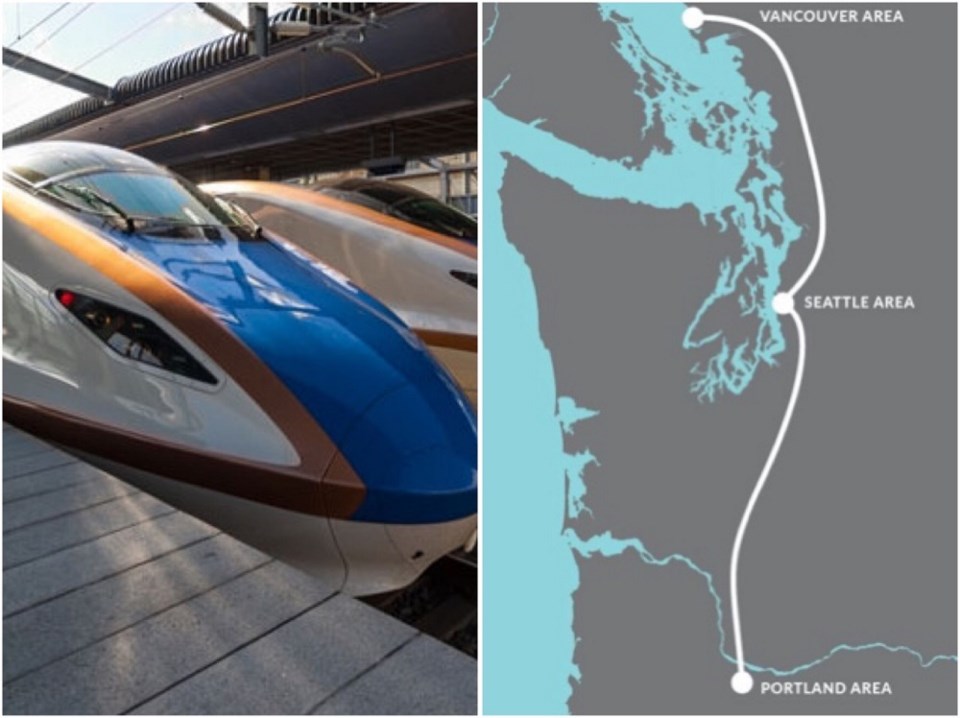Remember that idea of a bullet train that would connect Vancouver to other hubs in the Pacific Northwest?
It's still out there; it's just in the early planning stages.
However, many, many more decisions need to be made before a green light appears.
As part of efforts to kick it into high gear, the Tri-Cities Chamber of Commerce (TCCC) recently collaborated with four other organizations to pen a letter in hopes of garnering more support from politicians in Washington, D.C.
This included:
- Burnaby Board of Trade
- Delta Chamber of Commerce
- Greater Vancouver Board of Trade
- Surrey Board of Trade
The Cascadia Ultra-High Speed Ground Transportation project (UHSGT) was first introduced in 2019.
It laid out the possibility of a 400 km/h train, at a rough cost of $42 billion, to expand economic growth for the region and connect major cities like Vancouver; Seattle, Wash.; and Portland, Ore.
The train would help get cross-border travellers to their destination in little time. According to studies, such a mode of transportation could bring riders from Vancouver to Seattle in one hour.
In addition to safety and reliability for a fast-growing population, the TCCC believes the high-speed train would a "catalyst" for reducing greenhouse gas emissions and add more competition for local businesses.
"By connecting major urban centers in British Columbia, Washington and Oregon, the Cascadia UHSGT project could create ample opportunities for business growth, innovation, exchange of ideas and people on both sides of the border."
The project could also create up to 200,000 jobs, Port Moody-Coquitlam MLA Rick Glumac said in a statement from last fall.
At the time, the B.C. government contributed a third investment of $300,000 for the Washington State Department of Transportation to conduct more feasibility studies.
If approved and completed, revenue is projected to cover costs to build the train by 2055.
The letter to Pete Buttigieg, secretary for the U.S. Department of Transportation, co-signed by the TCCC, in full, is as follows:
Dear Secretary Buttigieg,
On behalf of five boards of trade and chambers of commerce in the metro Vancouver region, we are writing to express our collective support for the Cascadia Ultra-High-Speed Ground Transportation (UHSGT) project and the actions and cross-sector collaboration needed to make it a reality. The business community recognizes the importance of investing in transportation infrastructure to drive economic growth and the movement of goods and people and sees the importance of cross-border connectivity in this region of high potential.
Our members and the customers they serve want safe, reliable, and fast transportation options that enable them to get around in a convenient and sustainable way. Through its high-speed rail network, the UHSGT project presents a massive opportunity to help the Cascadia region strategically respond to a growing population, while serving as a catalyst for shared priorities including GHG emissions reduction, economic growth and regional competitiveness. By connecting major urban centers in British Columbia, Washington and Oregon, the Cascadia UHSGT project could create ample opportunities for business growth, innovation, exchange of ideas and people on both sides of the border.
The UHSGT would positively impact not only the Vancouver region but the entire Pacific Northwest in achieving our environmental and economic goals. Growth projections for the Cascadia region are startling, with the populations expected to increase by more than 30% ‐‐ or 3 to 4 million additional people – by 2050.
As with other major infrastructure projects, the development of the Cascadia UHSGT would require significant funding and coordination between different levels of government, as well as private sector partners. As such, we encourage all levels of government to continue to work closely with the business community on both sides of the border to find ways to make this vision a reality. As the business community in the Greater Vancouver region, we look forward to this work and we know our cross-border counterparts have demonstrated their support for this initiative in a February 2023 letter signed by dozens of American cities, counties, businesses and business associations.
Thank you for your leadership and your commitment to advancing sustainable transportation infrastructure and the movement of goods and people between Canada and the United States.





